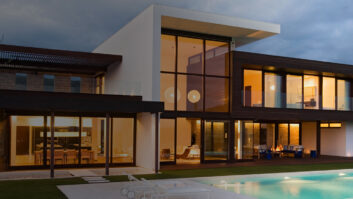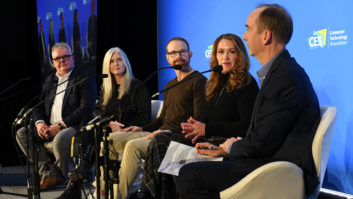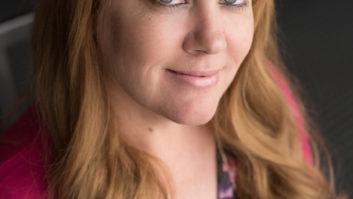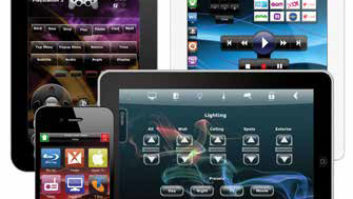Technology Enables Integrators and Manufacturers to Help People with Special Needs

Todd Jarvis (center) made liberal use of sensors, installing Sonic SPY-4 “curtain” monitors that turn on local lights at night
as his wheelchair-bound brother moves through his house. Jarvis is pictured with Vantage rep Chad Ballard of Paradigm System (right) and Steve Cooper of Sterling Home Technologies (left). Rachelle Friedman’s life changed forever in 2010 when a prank at her bachelorette party caused her to hit her head on the bottom of a pool, resulting in paralysis. Friedman has adapted to her condition courageously–NBC News reported that she’s making substantial progress in rehabilitation and she’s announced her intention to one day walk again and to have a baby. And that determination has been supported by AV systems technology that helps her interface with the house she and her fiancé had bought before the accident, allowing her to use everything from the kitchen to the secondfloor master suite.
This kind of residential systems assistance is making lives that have suddenly changed forever a bit easier, and in the process, opening up the discussion between integrators and clients about how, ultimately, all lives will change and have to face limits.
Mark Masters, sales and marketing director for Neuwave Systems, in Raleigh, NC, where Friedman also lives, said he heard about the bride-to-be’s plight through the local homebuilder’s association’s remodeling committee, on which he sits. Integrators from Neuwave Systems joined local building trades to renovate the Friedmans’ home. This included installing an elevator from the garage that accesses the main and the second floor, as well as a remodeling of the home’s kitchen to lower countertops and make appliances more accessible.
A Control4 HC-300 home controller allows this system to be viewed via an on-screen TV interface. Flat-screen displays in the master bedroom and bath and 12 zones of lighting are controlled via a combination of a Control4 7-inch portable touchscreen, 6-button touchpanels installed at a 36-inch height for accessibility–Control4 donated a substantial part of the home’s AV complement, just as Neuwave contributed its labor and expertise pro bono–and Friedman’s own Apple iPad.
“A project like this really shows how the iPad and tablets in general have become so ubiquitous in everyday life and how they can be easily integrated into system like this,” Masters said.
It’s also made Masters more aware of how residential AV systems can play larger roles in the lives of their owners, as did another recent project in which the homeowners wanted to anticipate their own imminent special needs for aging in place.
“One thing I’ve realized is that lighting control is a big deal when you have limited mobility,” he explained. “The iPad and iPhone make a huge difference for people with these kinds of issues.” Ironically, that same dynamic is also increasing the number of in-wall touchpads that Masters’ company has been installing.

Low placement of panels throughout the house makes them fully accessible to Tate Jarvis. Masters’ experience with a special-needs user has made him see these kinds of environments as a larger picture. “It’s made me think about a house from more of an infrastructure point of view,” he said. “Once you put it in those terms and put the idea that your needs are going to change at some point on the table, you can bring up things like occupancy sensors, things that might have seemed out of place otherwise.”
But it’s also made him realize that AV systems are more than a luxury. “It’s really great to know you made someone’s life easier and better as a result of what you did,” he said.
Brothers In Arms
The experience of Todd Jarvis, owner of Sterling Home Technologies in San Antonio, TX, was more personal than most. When Hurricane Ike hit Houston in 2008, a falling tree injured his brother, Tate, leaving him paralyzed from the waist down. While Tate would be permanently disabled, he built a house that he designed around his new wheelchairbound reality, and his brother Todd, who had founded his AV systems integration business several years earlier, played a major role in its adaptation.
When Vantage Systems approached Jarvis about looking for a house in the area to sponsor as a demonstration site, he suggested his brother’s nearly finished home. After explaining the situation to a Vantage executive, the company green-lighted the idea.
Todd said most of what eventually went into the house was exactly what he’s been installing in other homes, including lighting control, AV systems, and security cameras. What he learned, however, is that there are few yardsticks by which to measure each individual situation. He began by using Americans with Disabilities Act (ADA) specifications for accessibility, such as the height of control panels. But he and his brother quickly realized that even that needed to be truly customized.

The bathroom of Rachelle Friedman’s home is fully fitted for special needs. “Keypads usually are placed at [standing] shoulder height, and ADA suggested they be waist high so that someone in a wheelchair could reach them,” he explained. “But in many locations my brother was approaching the touchpanel sideways. When the touchpanel was that low, his elbow would hit the wall when he tried to use the panel. So I let him roll up to the wall and just point in a way that was comfortable, and that’s how we knew where to position to the panels,” which turned out to be about six inches higher than the ADA recommendations. But, Jarvis points out, if you have the ability to let the user determine the height that’s most comfortable for them, by all means do it. “Because those touchpanels are in the wall and not easily moved after that.”
Not all the touchpanels are fixed. Jarvis makes good use of several iPads to remotely control the Vantage automation system. It’s particularly useful for changing the HVAC settings in the middle of the night and the water temperature of his roll-in therapeutic Jacuzzi.
Todd Jarvis said he also made liberal use of sensors, installing Sonic SPY-4 “curtain” monitors that turn on local lights at night as his brother moves through the house. “Most sensors will shoot out a triangular or funnel-shaped pattern to look for motion; these are more like a curtain,” he explained. “They activate only when you pass directly in front of them and not when you walk by just in the vicinity.” These are also used in a room off the side of the shower that allows Tate to wheel in, switch to a second chair, and leave the one he showered in to be blown dry by an exhaust fan that the sensor activates. A more serious application is the sensor located deep inside a closet, at the rear of which is Tate’s gun safe. An alarm will alert him if any of his children happen to venture that far into the closet.
Todd Jarvis said that working on his brother’s home has made him more aware of certain things, such as how much more important an iPad or other tablet used for control is to someone with limited mobility. One thing that it’s changed about his work pattern is that he now usually installs automatic lights at critical points inside the house, like the edge of stairways, for almost all of his clients regardless of their condition or age. “It is all about how to make a house live around you, not the other way around,” he said.
Dan Daley is a freelance writer in Nashville, TN.







